Though William Morgan was awarded the Rome Scholarship in Engraving on the strength of his wood engravings, it is for his copper-plate line engravings of landscapes, animals and mythological subjects made between 1925 and 1931 that he is nowadays best remembered. During his Rome residency he made his first etchings – to which he later added engraved lines. In Rome, Morgan encountered the sober techniques of Renaissance Italian and German line engravers and began himself using the medium exclusively. It was, he considered, ‘a fuller and less conventional medium’ (Morgan qtd in Stokes, 122).
Morgan was born 19 October 1903, the son of a London schoolmaster William Henry Morgan. He was schooled at St Dunstan’s College, Catford where the art master was Slade-trained Alfred Carter. At age 17 in October 1920, Morgan enrolled at Camberwell School of Art to study painting under Albert Rutherston. He later transferred to the Slade School of Art under Professor Henry Tonks.
In 1923, Morgan took up the then popular craft of wood engraving. Self taught, he worked at home in the evenings – inspired by the prints of William Blake. In the autumn that year, Tonks suggested that Morgan enter the Rome Scholarship in Engraving. Morgan was shortlisted along with two students of Goldsmiths’ College, Graham Sutherland and Edward Bouverie Hoyton. The prints of short-listed entrants were displayed at the Royal Academy of Arts. Morgan won the Scholarship worth £250 a year. (Hoyton won the Rome Scholarship in Engraving in March 1925).
The scholarship allowed Morgan to travel extensively in Italy – in Tuscany, Umbria, Aquila and the Abruzzi. Returning to England in 1928, Morgan, Skeaping and Hepworth exhibited together at the Beaux Arts Gallery, Bruton Place, New Bond Street, London. The Gallery continued to represent Morgan and publish his prints. Back in the UK, Morgan settled in Cornwall where he made intaglio prints drawn from his time in Italy.
In his 1928 article on Morgan’s engravings for Artwork magazine, Hugh Stokes described the manifold opportunities that existed for collectors of present-day etchings, and the excitement of a ‘quest for new genius’. Though he felt that Morgan’s art was ‘derivative and imitative’, he was evolving a ‘distinct personality’. He considered the etched lines of Anticoli and Saracinesco to be ‘stiff and determined’ and ‘hard and unrelenting’. The ‘gloomy cross-hatching’, he pointed out, was also to be seen in the prints of Edward Bouverie Hoyton and in the ‘drawings of the whole school’.
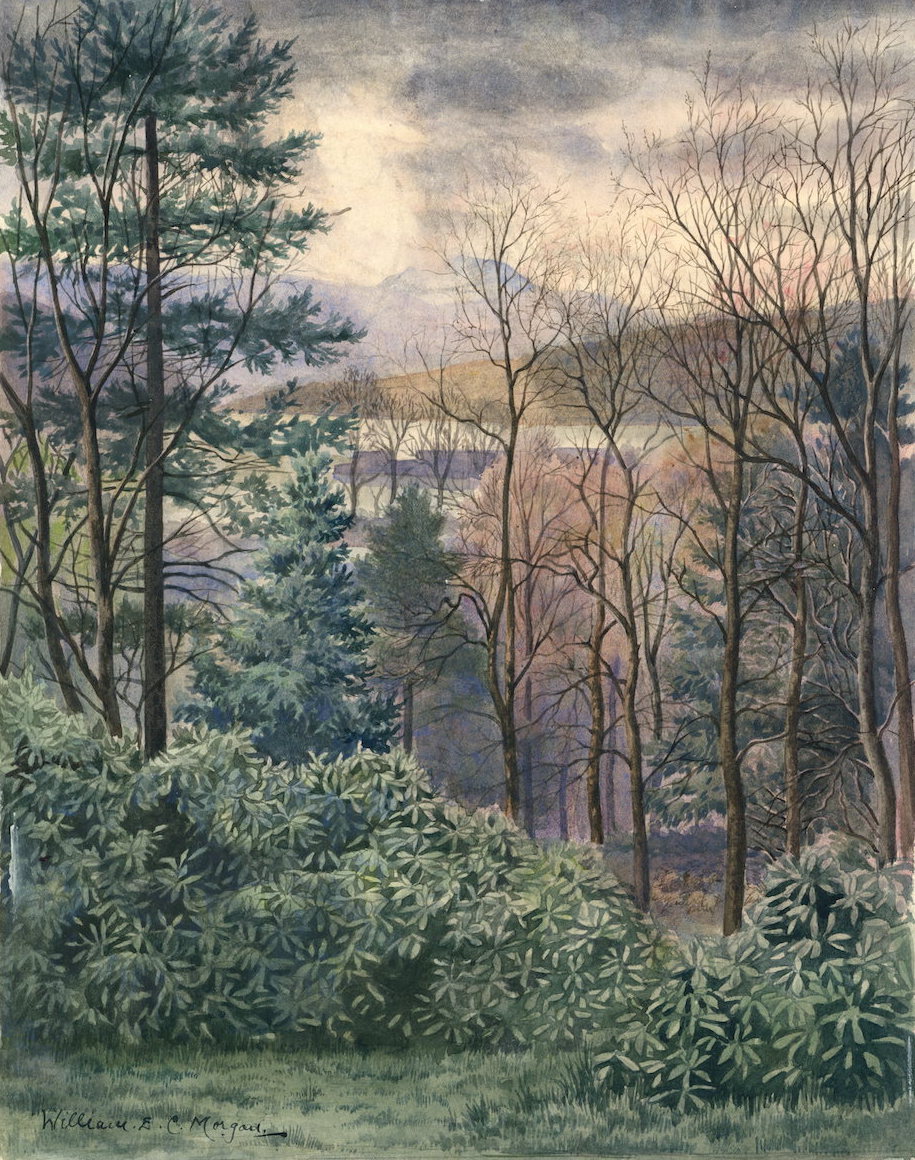
Morgan’s final prints were executed in Scotland. Escaping the effects of the Depression in the south of England, he moved in the early 1930s to Craigbhea, Ardtornish near Morvern in rural Argyllshire. He made his last print in 1938 by which time he was suffering from problems with his eyesight. In Dolman’s Dictionary, Morgan stated that his recreational interests were boating, fishing, bowling, and cycling.
Morgan eventually relocated to live near his daughter in Switzerland.
The largest collection of William E. C. Morgan’s prints is held by Georgetown University, the gifts in part of Annette Wuthrich-Morgan and Mr and Mrs Daniel W. Strishock. In addition to 49 of his 53 known prints, the collection includes original drawings, trial proofs and Morgan’s printmaking tools.
Catalogue of Engravings
William Evan Charles Morgan 1903-1979
A work in progress by Robert Meyrick
1
[Gathering of Fisher Folk by the Sea] c.1923
wood engraving, 153 x 208 mm, edition not known
published:
exhibited:
reproduced:
collection: Aberystwyth University
Previously unrecorded.
2
The Cottage in Surrey 1924
wood engraving, 96 x 128 mm, edition 50
published: Beaux Arts Gallery, September 1928, 2 guineas
exhibited: Beaux Arts Gallery, June 1928 (40)
collection: Aberystwyth University; Georgetown University
3
The Woodman 1924
wood engraving, 109 x 45 mm, edition 50
published: Beaux Arts Gallery, September 1928, 1 guinea
collection: Aberystwyth University; Georgetown University
4
The Visit of the Shepherds 1924
wood engraving, 108 x 115 mm, edition 50
published: Beaux Arts Gallery, September 1928, 2 guineas
exhibited: Beaux Arts Gallery, June 1928 (41)
collection: Georgetown University
5
The Expulsion 1924
wood engraving, 140 x 165 mm, edition 50
published: Beaux Arts Gallery, September 1928, 3 guineas
exhibited: Beaux Arts Gallery (as Paradise Lost), June 1928 (35)
collection: Georgetown University (x 2)
Morgan’s successful submission for the Rome Scholarship in Engraving. Also recorded as Paradise Lost.
6
The Philosophers 1924
wood engraving, 152 x 206 mm
collection: Georgetown University
Morgan’s successful submission for the Rome Scholarship in Engraving.
7
The Ghost of Abel 1925
wood engraving, 179 x 136 mm, edition 50
published: Beaux Arts Gallery, September 1928, 3 guineas
reproduced: The New Woodcut, Studio, London 1930 p.5
exhibited: Beaux Arts Gallery, June 1928 (37)
collection: British Museum (1928-7-31-1); Georgetown University
Morgan’s successful submission for the Rome Scholarship in Engraving.
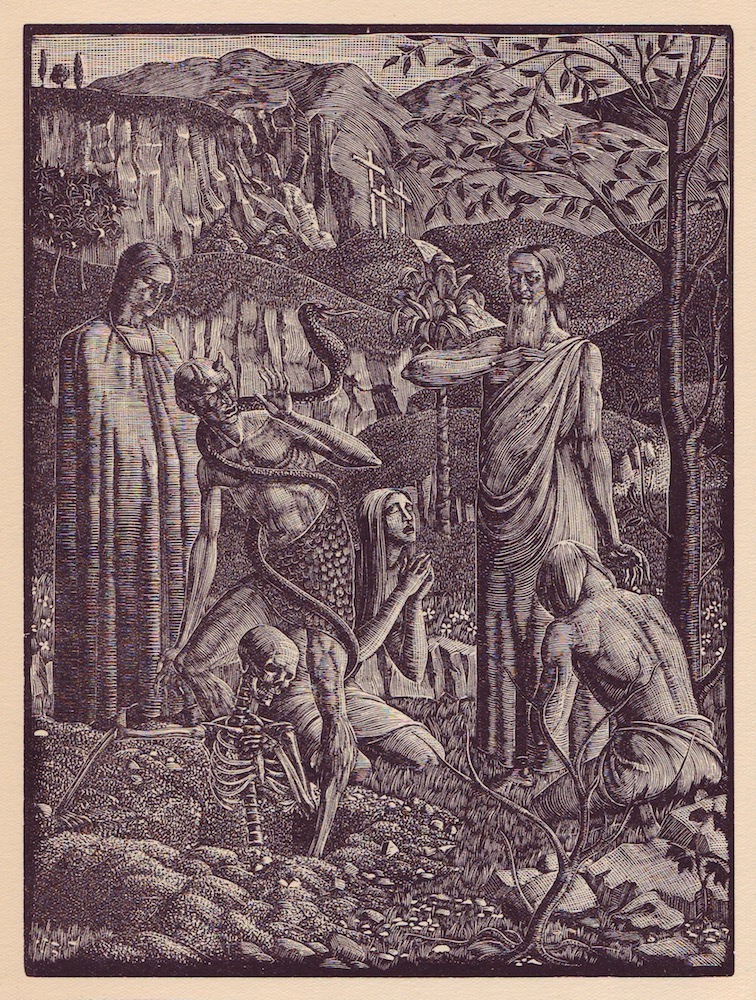
8
The Crucifix 1925
wood engraving
9
The Crucifixion 1925
wood engraving, 135 x 172 mm with an arched top, edition 50
published: Beaux Arts Gallery, September 1928, 2½ guineas
exhibited: Beaux Arts Gallery, June 1928 (36)
collection: Georgetown University
10
[Mountain Madonna] c.1925
line engraving, 88 x 63 mm, edition 3
collection: Georgetown University
11
[Mountain Pilgrimage] c.1925
line engraving, 180 x 157 mm
collection: Georgetown University
12
Despair 1926
woodcut, 142 x 95 mm, edition 50
published: Beaux Arts Gallery, September 1928, 2 guineas
exhibited: Beaux Arts Gallery, June 1928 (38)
collection: Aberystwyth University; British Museum (1928-7-31-2); Georgetown University
13
Outside the Walls of Jerusalem 1926
woodcut, 125 x 83 mm, edition 50
published: Beaux Arts Gallery, September 1928, 2 guineas
exhibited: Beaux Art Gallery, June 1928 (39)
collection: Aberystwyth University; British Museum (1928-7-31-3); Georgetown University
14
The Citadel 1926
line engraving, 170 x 291 mm
exhibited: the drawing, Beaux Art Gallery, June 1928 (49)
collection: Georgetown University
15
Siena 1926
line engraving, 201 x 255 mm
collection: Georgetown University
16
Orvieto 1926
line engraving, 191 x 299 mm, edition 63 (or 50?)
published: Beaux Arts Gallery, March 1928, 4 guineas
reproduced: Artwork No.14 1928 p.124
collection: Aberystwyth University; British Museum (1960-4-9-385); Georgetown University; Fine Arts Museum of San Francisco (1963.30.13406)
Beyond an orchard, the Umbrian hill town of Orvieto is seen from its fortress walls.
17
Orvieto Roofs (A) 1926
line engraving with part of the contour etched, 155 x 188 mm, edition 50
published: Beaux Arts Gallery, March 1928, 3 guineas
exhibited: Beaux Arts Gallery, June 1928 (26) + drawing (46)
reproduced: Studio Vol.XCV 1928, p.333
collection: Georgetown University (x2); British Museum (1932-5-14-4)
The pan-tiled rooftops of medieval houses. Narrow streets weave through the walled town. Distant landscape.

18
Anticoli 1927
line etching and line engraving, 192 x 309 mm, edition 50
published: Beaux Arts Gallery, March 1928, 4 guineas
exhibited: Beaux Art Gallery, June 1928 (28) + drawing (44)
collection: Georgetown University
A panorama of the Sabine Hills in the Abruzzi. Saracinesco is a commune (municipality) in the Province of Rome in the Italian region Lazio, located some 40km northeast of Rome.
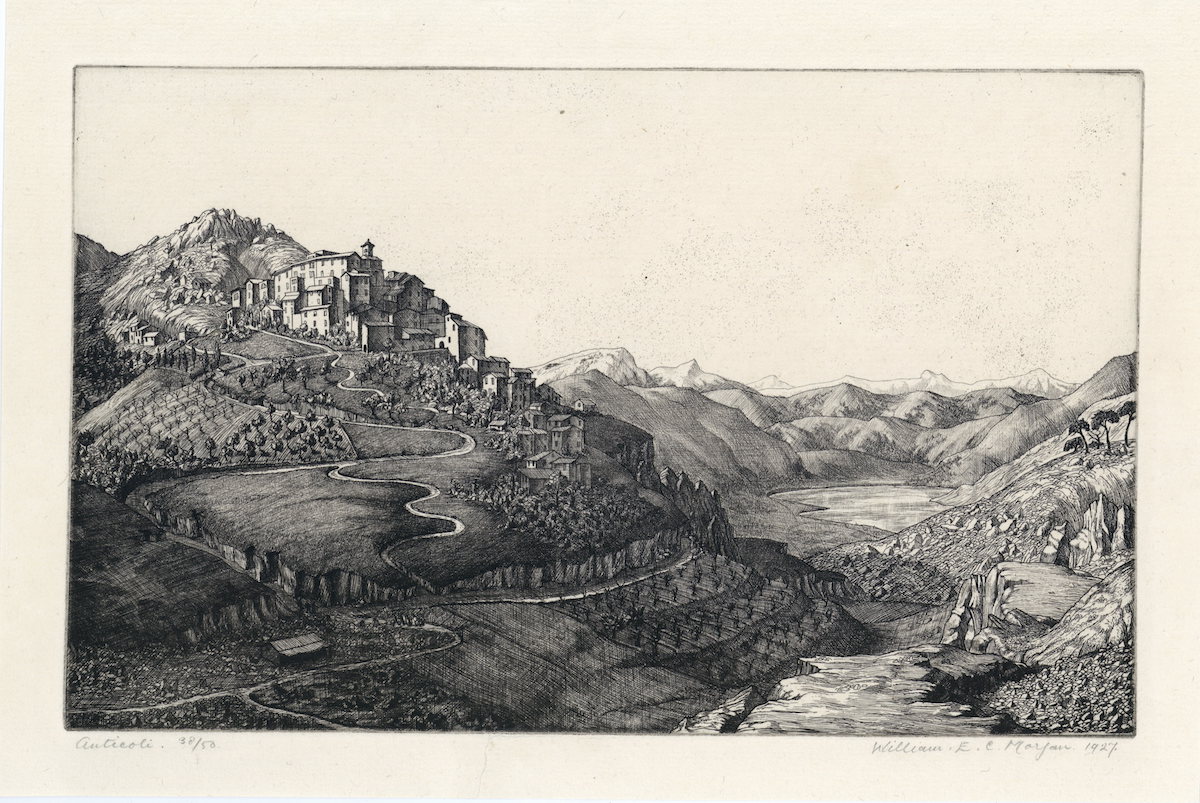
19
Bells of Alba 1927
line engraving, 150 x 99 mm, edition 50
published: Beaux Arts Gallery, Spring 1928, 2½ guineas
exhibited: Beaux Arts Gallery, June 1928 (30) + drawing (50)
reproduced: Studio Vol.XCV 1928, p.334; reproduced: Artwork Vol.?? 1928 p.123
collection: British Museum (1930-1-14-88); Contemporary Art Society; Georgetown University (x 2)
Three church bells suspended from a low wooden frame, foreground figure and landscape background.

20
The Deserted Farm 1926
line engraving, 240 x 350 mm
collection: Georgetown University
21
Antonio 1926
line engraving with a little drypoint, 260 x 214 mm, edition 50
published: Beaux Arts Gallery, March 1928, 4 guineas
exhibited: Beaux Arts Gallery, June 1928 (25) + drawing (43)
reproduced: Studio Vol.XCV 1928, p.332
collection: Aberystwyth University; Georgetown University (x 2); British Museum (1931-1-11-89)
An Italian villager with flute sits before landscape.
22
Saracinesco 1927
etching and line engraving, 203 x 303 mm, edition 50
published: Beaux Arts Gallery, March 1928, 4 guineas
exhibited: Beaux Arts Gallery, June 1928 (29)
reproduced: Artwork Vol.?? 1928 p.123
collection: Georgetown University
An open panorama of the Sabine Hills with valleys and mountains of the Abruzzi. Anticoli Corrado is a commune in the Province of Rome in the Italian region Latium, located about 40 km northeast of Rome.

23
The Source 1927
line engraving, 283 x 140mm, edition 50
published: Beaux Arts Gallery, March 1928, 4 guineas
editioned on Van Gelder laid paper
exhibited Royal Academy of Art 1928 (1157); Beaux Arts Gallery, June 1928 (24) + drawing (42); Chicago Society of Etchers International Exhibition, Art Institute of Chicago 1928 (Logan Medal)
reproduced: Studio Vol.XCV 1928, p.331; The Art Digest August 1928, p.14
collection: British Museum (1927-10-10-51); Georgetown University (+ 2 early states)
A naked huntress, spear in hand, stands beside the source of a stream. Elaborate in its detail and pattern, and devoid of aerial perspective, The Source is engraved in the manner of Albrecht Dürer and Marcantonio Raimondi.

24
Italian Cottage 1928
drypoint, 182 x 149 mm, edition 78
published: Beaux Arts Gallery, June 1928, 5 guineas
exhibited: Beaux Arts Gallery, June 1928 (33) + drawing (52)
reproduced: Artwork Vol.?? 1928 p.123
collection: Georgetown University (x 2)

25
Italian Hill Farm 1928
drypoint, 163 x 214 mm, edition 78
published: Beaux Arts Gallery, June 1928, 5 guineas
exhibited: Beaux Arts Gallery, June 1928 (34) + drawing (53)
reproduced: Artwork Vol.?? 1928 p.124
collection: Georgetown University; Fine Arts Museum of San Francisco (1931.18)
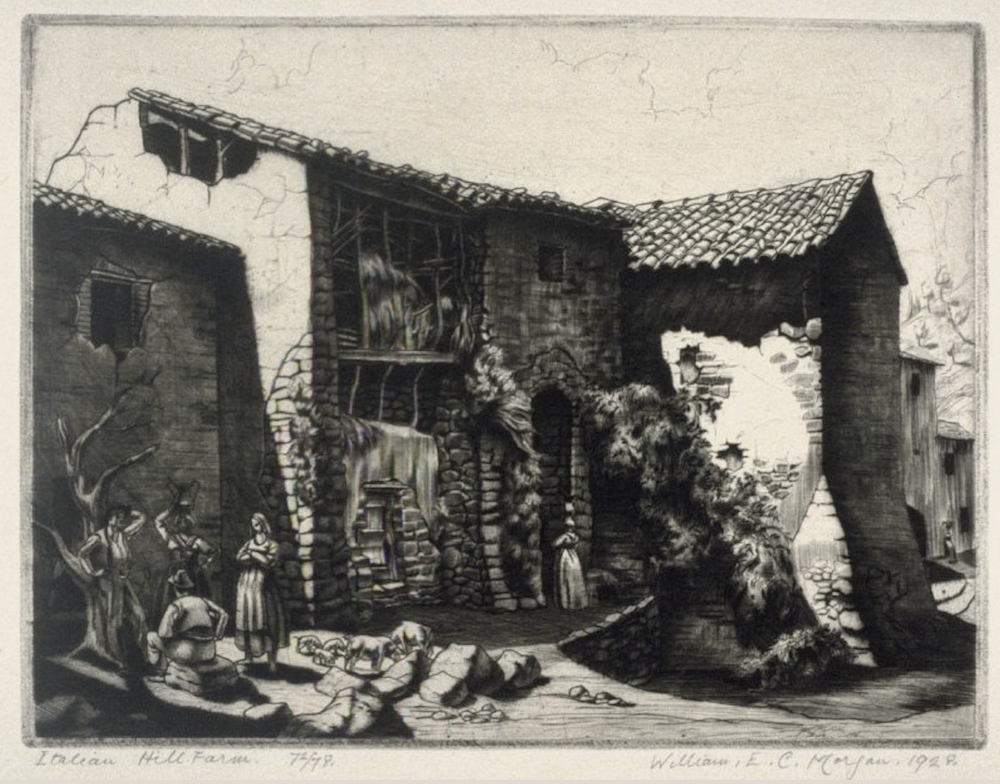
26
Italian Hill Town 1928
line engraving, 150 x 186 mm, edition 78
published: Beaux Arts Gallery, June 1928, 5 guineas
exhibited: Beaux Arts Gallery, June 1928 (31) + drawing (47)
collection: British Museum (1960-4-9-386); University of Chicago (1967.116.185); Georgetown University (x 2); University of Michigan (1949/1.138)
Also known as Italian Hill Village.

27
Nymphs Bathing 1928
line engraving, 200 x 282 mm, edition 83
published: Beaux Arts Gallery, July 1928, 6 guineas
printed by David Strang
exhibited: Beaux Arts Gallery, June 1928 (32) + drawing (55); Royal Academy of Art 1930 (1081)
reproduced: Studio Vol.XCVI 1928, p.422; Etchings of Today, Studio, London 1929, pl.30
collection: Georgetown University; British Museum (1932-5-14-5); Fine Arts Museum of San Francisco (1963.30.13408)

28
The Water Carriers 1928
line engraving, 213 x 100 mm, edition 60
published: Beaux Arts Gallery, January 1929, 4 guineas
reproduced: Print Collectors’ Quarterly Vol.16
exhibited: the drawing Woman Carrying Water, Beaux Arts Gallery, June 1928 (51)
collection: Aberystwyth University; Georgetown University; British Museum (1934-5-21-2)
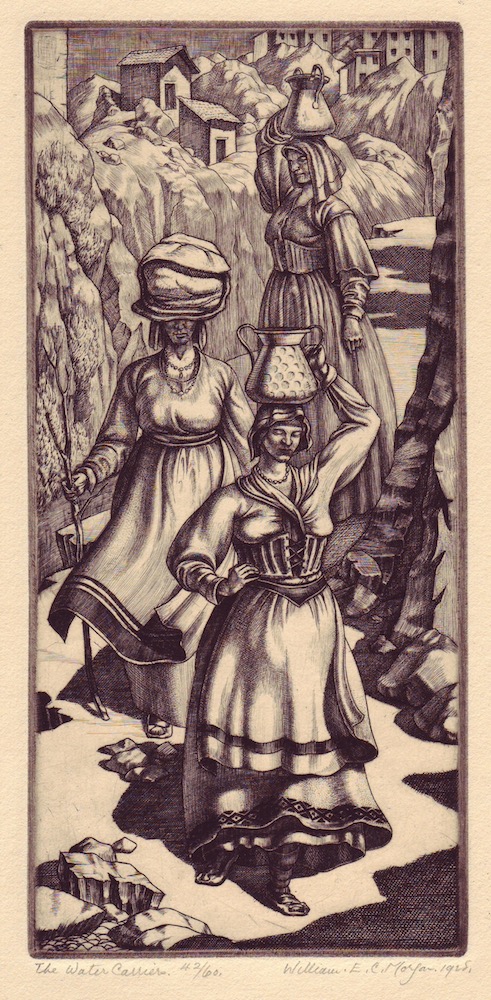
29
Perseus 1929
line engraving, 223 x 217 mm, edition 70
published: Beaux Arts Gallery, April 1929, 5 guineas
exhibited: Royal Academy of Art, 1929 (1093)
collection: Aberystywth University; Georgetown University (+ 1st state); British Museum (1931-11-14-30); Museum of Fine Arts, Boston; Fine Arts Museum of San Francisco (1963.30.13407)

30
Young Love Birds 1929
line engraving, 137 x 133 mm, edition 50
publication price: 2½ guineas
collection: Aberystwyth University; Ashmolean Museum, Oxford; British Museum (1960-4-9-388); Georgetown University
31
Harnessed Antelope 1929
line engraving, 125 x 149 mm, edition 50 (or 63?)
publication price: 2 guineas
exhibited: Royal Academy of Art, 1932 (1110)
collection: Aberystwyth University; British Museum (1960-4-9-387); Georgetown University
32
Portrait of the Artist 1930
line engraving, 249 x 189 mm, edition 40
publication price: 3 guineas
exhibited: Royal Academy of Art 1931 (1266)
collection: Aberystwyth University; British Museum (1933-4-8-67); Georgetown University
Self-portrait holding an accordion and smoking a clay pipe. Aberystwyth University purchased a self-portrait drawing from the Beaux Arts Gallery in 1928 (3 guineas); Georgetown University holds a sepia ink study for Portrait of the Artist.
33
Tulips 1930
line engraving, 251 x 174 mm, edition 50
collection: Georgetown University
34
The Brook 1930
line engraving, 190 x 165 mm, edition 50
published: Beaux Arts Gallery, July 1930, 4 guineas
exhibited: Royal Academy of Art, 1931 (1281)
reproduced: Studio Vol.C 1930, p.117
collection: Aberystwyth University; Smithsonian American Art Museum (1935.13.230); British Council; British Museum (1933-4-8-68); Georgetown University
35
Star of Bethlehem 1930
wood engraving, 111 x 101 mm
collection: Georgetown University
Mailed as a Christmas card.
36
The Waterfall 1931
line engraving, 133 x 181 mm, edition 50
exhibited: Royal Academy of Art, 1932 (1111)
collection: Georgetown University; Fine Arts Museum of San Francisco (1963.30.13409)

37
Vivandiere – The Suffolk Filly 1931
etching with drypoint, 250 x 353 mm
editioned on J Whatman laid paper
exhibited: Royal Academy of Art, 1933 (1284)
collection: British Museum (1940-6-1-47); Georgetown University
Bred on the Rutland farm of Owen Hugh Smith [Cat. 38], Vivandiere was Champion Mare at Royal Agricultural Society Show, Manchester in 1930. She is a thoroughbred chestnut Suffolk Punch, an English breed of heavy draft horse prized for its power, stamina, longevity and docility. Shorter and more sturdily built than the feather-hoofed Shire horse, the Suffolk Punch was originally bred to plough the clay soils of East Anglia. Subsequently, they were used to pull brewers’ drays, omnibuses and, in wartime, for pulling heavy artillery. The Suffolk Punch was still popular in the 1930s, but post-war mechanization resulted in a sharp decline of its numbers. A ‘vivandiere’ is woman who accompanies troops to sell them food, supplies and alcohol.

38
Portrait of Owen Hugh Smith 1931
line engraving, 310 x 228 mm
The son of Hugh Colin Smith, Governor of the Bank of England and Lieutenant of the City of London, Owen Hugh Smith JP (1869-1958) lived at Langham Old Hall in Oakham, Rutland. He acquired the Hall in 1922 and commissioned architect Harry Goodhart-Rendel [Cat. 49] to design a west wing and improve the original two-storey stone building, which dates back to 1665. On the adjoining farm, Smith bred pedigree Red Poll Cattle and Suffolk Punches [Cat. 37].
39
Portrait of Alfred Ralph Wagg 1931
line engraving, 305 x 246 mm
Alfred Ralph Wagg (1877–1969) of the merchant banking company. See: Oxford Biography Index.
40
The Forge, Ardtornish 1932
drypoint, 247 x 300 mm, edition 30
collection: Smithsonian American Art Museum (1935.13.231); British Museum (1960-4-9-389); Georgetown University
A blacksmith working at his forge in Ardtornish, the village on the Sound of Mull that Morgan made his home.
41
Visit of the Shepherds II 1932
wood engraving, 168 x 235 mm
collection: Georgetown University
Mailed as a Christmas card.
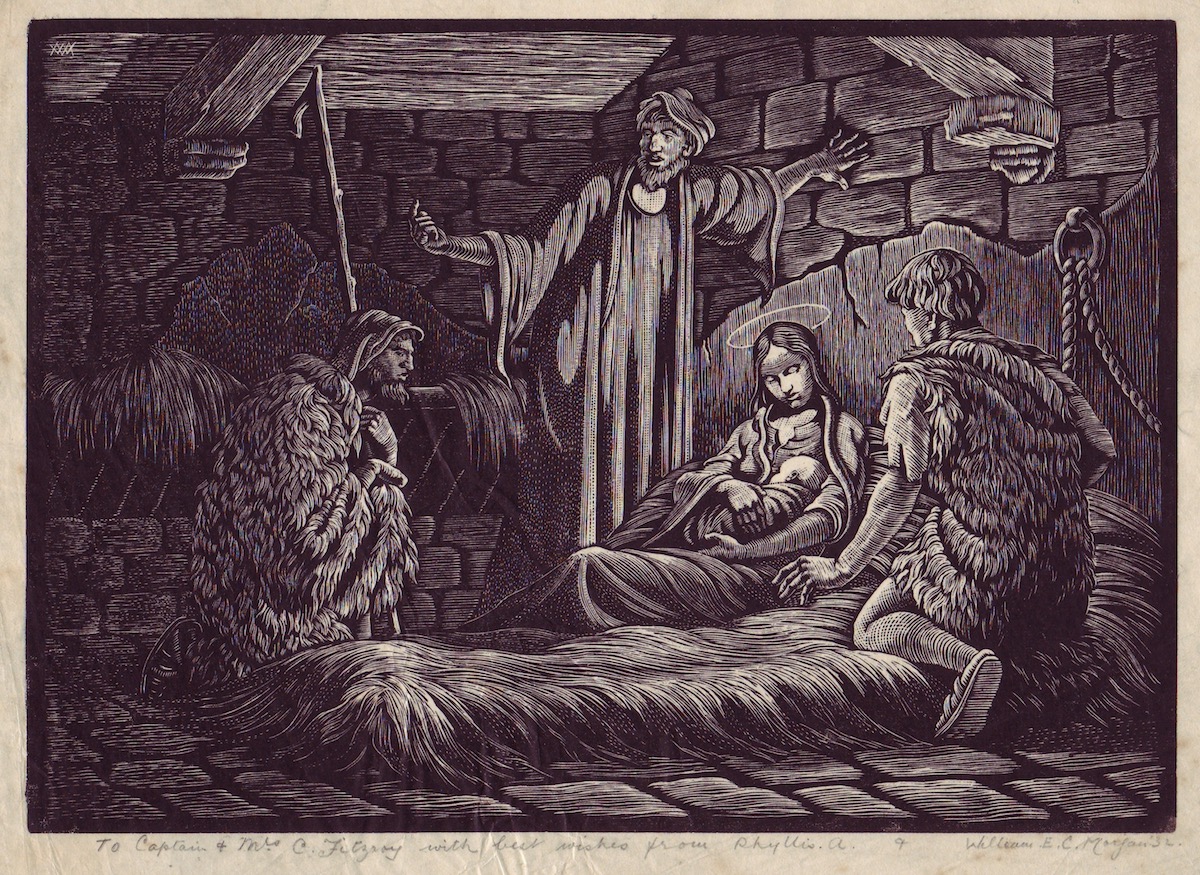
42
And Lo, the Angel of the Lord Came unto Them 1933
wood engraving, 169 x 235 mm
collection: Georgetown University
Mailed as a Christmas card.
43
Cloudburst Chaos in a Highland Burn March 1935
etching, 248 x 383 mm
exhibited: Royal Academy of Art, 1935 (1270)
collection: Georgetown University
44
Kinlochaline Castle April 1935
etching, 291 x 395 mm, edition 63
collection: British Museum (1960-4-9-642)
Escaping Depression-era London, Morgan relocated to Ardtornish in Argyll on the west coast of Scotland in the early 1930s. In the grounds of the Ardtornish estate at Morvern stands the ruins of Kinlochaline Castle, onetime seat of the Lords of the Isles. The 12th-century fortress is strategically located on a rocky summit at the head of Loch Aline on the Sound of Mull. The distinctive four-storey tall rectangular keep dates from the 15th-century. The castle was burned in 1644 during the wars of Montrose, suffered damage from Cromwell’s troops in the 1650s, attacked by the Earl of Argyll in 1679, and eventually abandoned about 1690.
45
Black Cock I – Standing 1938
wood engraving, 115 x 152 mm
collection: Georgetown University
46
Black Cock II – Strutting 1938
wood engraving, 115 x 153 mm
collection: Georgetown University
47
Hind and Calf, Ardtornish 1938
etching, 120 x 211 mm
reproduced: The Print Collectors’ Chronicle Vol.1, No.4, USA Sept. 1939
collection: Georgetown University
Red deer on the 60-square-mile Ardtornish Estate which stands among the hills, glens and lochs of the Morvern peninsular in the south-west corner of the Scottish Highlands.
48
Stag Calf 1938
line engraving, 128 x 97 mm
49
Bookplate: Harry Stuart Goodhart-Rendel
line engraving, 93 x 67 mm
collection: Georgetown University
An English architect, writer and musician, Harry Stuart Goodhart-Rendel CBE (1887-1959) was educated at Eton and studied music at Trinity College, Cambridge. He established his own architectural practice, undertook numerous ecclesiastical commissions, and served as Slade Professor of Fine Art at Oxford University 1933-1936. In 1926 he designed a new west wing for Langham Old Hall on behalf of Owen Hugh Smith [Cat. 38]. Goodhart-Rendel’s many publications include Nicholas Hawksmoor (1924), Fine Art (1934) and English Architecture Since the Regency (1953). His maternal grandfather was Stuart, 1st Baron Rendel of Hatchlands (1834-1913), Liberal MP for Montgomeryshire and founder member of the University College of Wales at Aberystwyth. On his death in 1959, Goodhart-Rendel left Hatchlands, his family’s 18th-century mansion in Surrey, to the National Trust.
50
Bookplate: Sir John Stirling Maxwell
etching, 101 x 74 mm
collection: Georgetown University
A politician and philanthropist, Sir John Maxwell Stirling-Maxwell Bt (1866-1956) was, like Goodhart-Rendel [Cat. 49], educated at Eton and Trinity College, Cambridge. He was Conservative MP for Glasgow and at various times Chairman of the Forestry Commission, Royal Fine Art Commission for Scotland, and the Ancient Monuments Board (Scotland). A Trustee of the National Galleries of Scotland and author of Shrines and Homes of Scotland (1937), he was a founder member of the National Trust for Scotland, serving as its President 1943-1956. In 1966, his daughter Anne gifted Pollok House and Estate, the Maxwell ancestral home for almost 700 years, to the City of Glasgow. Now managed by the National Trust for Scotland, Pollok House displays Maxwell’s art collection. It holds the finest private collection of Spanish paintings in the UK with works by El Greco, Goya and Murillo. Maxwell was also involved in finding a suitable home for the Burrell Collection. In Pollok Park, Glasgow Corporation erected a museum to house the art treasures amassed by Sir William Burrell. Stirling Maxwell’s important collection of early 20th-century British etchings and engravings – including a group of engravings by W. E. C. Morgan – was dispersed at auction at Bonham’s Edinburgh in June 2015.
51
Bookplate: Royal Institute of British Architects
line engraving, 101 x 74 mm
collection: Georgetown University
52
Bookplate: Victoria Wemyss
line engraving, 110 x 73 mm
collection: Georgetown University
53
Bookplate: Roger Wrightson
line engraving, 112 x 60 mm
collection: Georgetown University
References
Dolman, Bernard (ed.). Dictionary of Contemporary British Artists 1929. London: Antique Collectors’ Club, 1981.
Haller, Joseph. A The Prints of William E. C. Morgan 1903-1979. Typescript exhibition catalogue. Washington DC: Georgetown University, 1994.
Gaunt, William. Etchings of Today. London: Studio, Special Spring Number, 1929.
Salaman, Malcolm. The New Woodcut. London: Studio, Special Spring Number, 1930.
Salaman, Malcolm. ‘The Engravings of William E. C. Morgan’. London: Studio Vol. XCV 1928, pp.328-334.
Stokes, Hugh. ‘The Engravings of William Morgan’. London: Artwork No. 14 Summer 1928, pp.121-125.
Aberystwyth University, Receipts 302 and 243.
Publications
W. E. C. Morgan, F. W. Cooper, W. G. Trust, John Betjeman (Intro.). The Thatcher’s Craft. London: Rural Industries Bureau, 1961.
W. E. C. Morgan, A. Zanni, C. A. H/ Tucker. Decorative Ironwork: Some Aspects of Design and Technique. London: Rural Industries Bureau, 1962.
Exhibitions 1928-1936
Sculpture, Engravings and Drawings by Barbara Hepworth, William E. C. Morgan, John Skeaping. Beaux Arts Gallery, London. 8-30 June 1928.
Sculpture, Drawings and Drypoints by John Skeaping and Barbara Hepworth, and Engravings and Drawings by William E. C. Morgan. Alex Reid and Lefevre, Glasgow. September 1928.
Johnson and Greuztner cite the following exhibits: Beaux Arts Gallery (41); Connell and Sons (4); Fine Art Society (11); Walker Art Gallery, Liverpool (7); Royal Academy of Art (11). In addition to prints, Morgan exhibited the following at the Royal Academy of Arts: Landscape with Rocks 1933 (968); and Fall on Trees wash, chalk and ink 1935 (1235).
Additional drawings exhibited at the Beaux Arts Gallery, June 1928: Self Portrait (48); Drawings for a Woodcut (54); Wild Arum Leaves and Hart’s-Tongue Fern (56); Olive Trees (57); Olive Trees No.2 (58); Beech Tree (59); Young Beech (60); Odds and Ends outside a Farm (61); Cornish Coast (62).
Collections
Museum of Fine Arts of San Francisco, Achenbach Foundation for the Graphic Arts (5)
Georgetown University, Washington DC (49)
University of Chicago, Smart Museum of Art (1)
Government Art Collection UK (1, Salcombe Harbour, oil on canvas, presented in 1970 by the Rural Development Commission)
Smithsonian American Art Museum, Washington DC (2, gift of the Chicago Society of Etchers)
Aberystwyth University School of Art Museum and Galleries (17)
British Museum, London (19)
